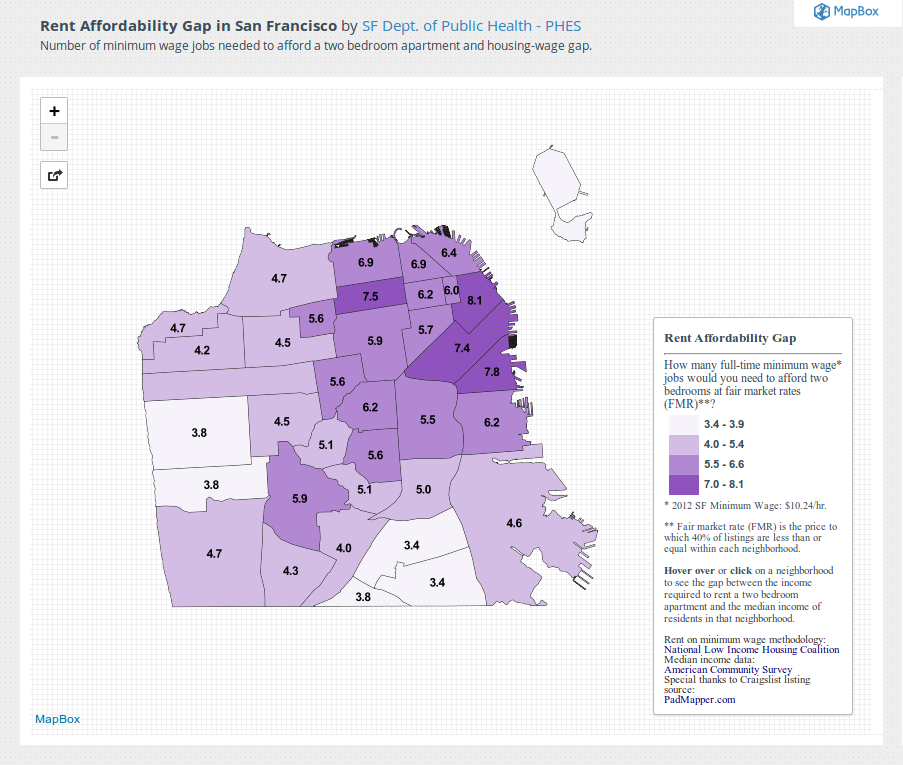A "Hacker's" Guide to the Bay Area
This guide is targeted to “hackers” who wish to move to the San Francisco Bay Area, specifically San Francisco or Silicon Valley. This guide reflects my lifestyle - male, single, focused on work (in tech) and saving money, but keeping an eye on my health. I will only focus on things deemed important to “Hackers”.
More discussion here.
Japanese version by @legoboku.
Table of Contents
|
(A little bit of History and) Geography
The San Francisco Bay Area, commonly known as the Bay Area, is a region in Northern California (NorCal) that surrounds the San Francisco and San Pablo estuaries. It is named after the largest bay, the San Francisco Bay (which was named after St. Francis).
Approximately 7.15 million people live in the area, scattered over aproximately 6,984 sq miles (18,088 km^2).
The Bay Area’s nine counties are Marin, Sonoma, Napa and Solano in the North, Contra Costa and Alameda in the East, Santa Clara in the South Bay and San Francisco and San Mateo in the Peninsula.
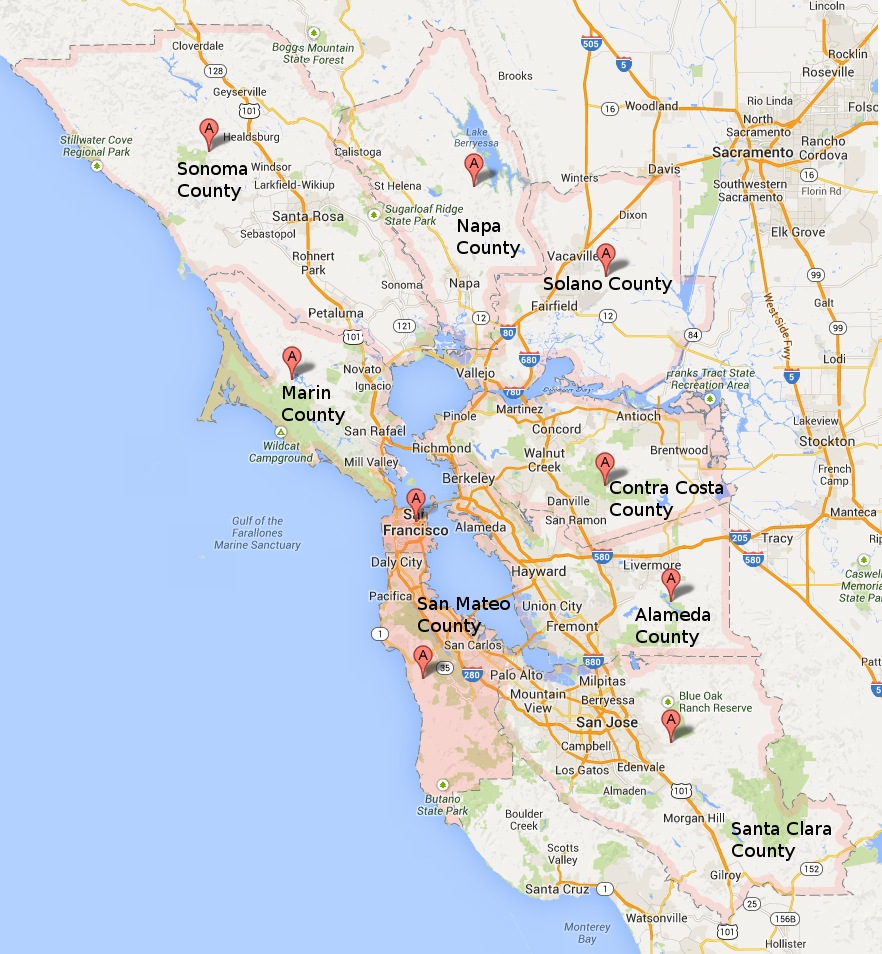
Silicon Valley
Silicon Valley is the historical name used to reference the southern part of the Bay. It is not a specific town or county, but a fairly wide region.
Ground zero is the Santa Clara Valley. Over the years, other surrounding areas have been included. Nowadays, the Valley has shifted to an area that stretches from San Mateo to San Jose. More recently, it has been common to include San Francisco as part of the Valley, but I will keep the distinction.
![]()
The most important cities in the Valley are:
-
San Jose: eBay, Adobe, Cisco, IBM Almaden Research Center
-
Santa Clara: Intel, Nvidia, Applied Materials
-
Cupertino: Apple
-
Sunnyvale: AMD, Juniper, Yahoo
-
Mountain View: Google, Intuit, Linkedin, Mozilla, Symantec, NASA Ames Research Center
-
Palo Alto: HP, Xerox PARC, IDEO, Stanford University, Palantir, VMware, Tesla, SAP
-
Menlo Park: Facebook, SRI International
-
Redwood City: Oracle, Evernote, EA
But startups, medium and large companies can be found virtually anywhere in the area. And the high price of rents has been pushing companies to spread further and further out of the original Valley.
The Valley has two major transportations channels that go through it:
- Caltrain, that goes from San Francisco to San Jose, making stops in every major city
- Highway 101, that also goes across the City and the Valley
Companies try to stay close to these transportation arteries (especially the Caltrain).
San Francisco
San Francisco has a land area of about 46.9 square miles (121 km^2) and a estimated population of 825,863 (2012 Census).
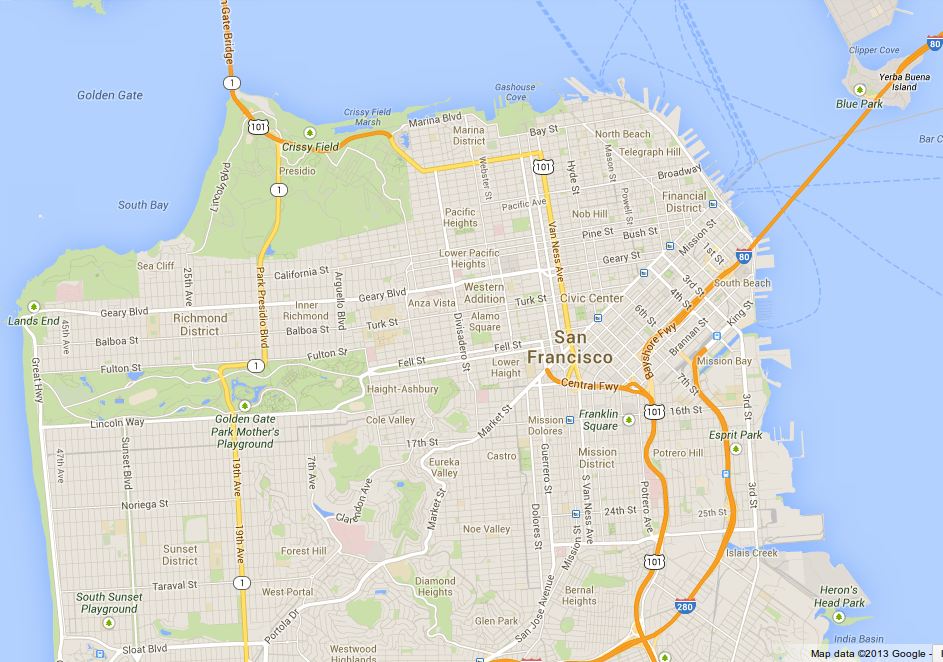
Some major transit arteries:
-
Market Street: goes diagonally across the city, starting at The Embarcadero (northeast) until Corbett Avenue (southwest) in the Twin Peaks.
-
Van Ness/South Van Ness Avenue: goes north-south, from Bay St. (north), cuts through Market St., until Cesar Chavez St (South).
-
Geary Boulevard/Street: goes east-west, from Market St. to 48th Avenue in the Richmod District (west), close to the Ocean.
The City has over 100 neighborhoods. Tech activity is concentrated in the SoMa (South of Market) and Mission neighborhoods, but you’ll even hear startup talk in coffee shops in the Sunset.
Twitter, Quantcast, Opentable, Salesforce, Yelp, The Climate Corporation, Zynga, Dropbox and Uber are some examples of tech companies that have chosen to settle in the City.
East Bay
Compared to the Valley or San Francisco, the East Bay does not see much relevant action in technology or startups. Still, it has some points of interest and it might become active as rents skyrocket in the City and the Valley and companies decide to look elsewhere to settle (it has certainly already happened with the people - more and more people are moving to Oakland, Emeryville and Berkeley).
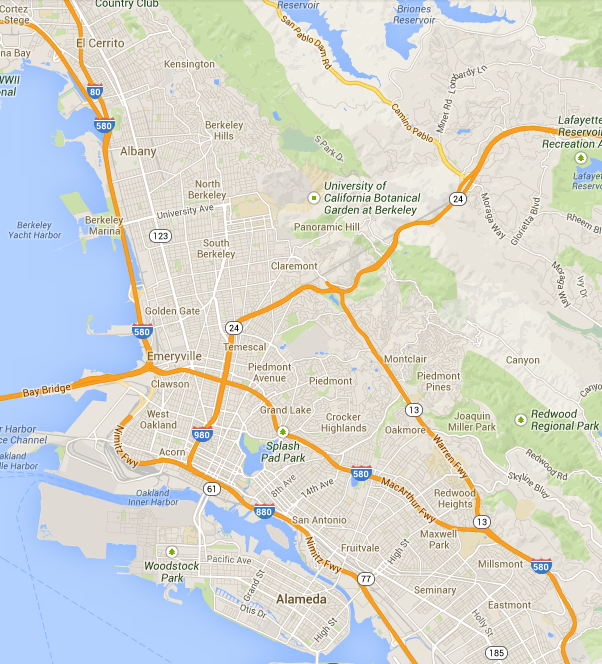
Berkeley is one of the most relevant cities in the East Bay. It is home to University of California, Berkeley (some famous alumni: Gordon Moore, Eric Schmidt, Steve Wozniak, Daniel Kahneman).
Oakland is not known for being a tech city, but nevertheless it is the home of Ask.com and Pandora, among other startups that are moving into the area.
Living
Living in the Bay Area is not for the faint of wallet. Certain parts of the Bay Area are toe-to-toe with Manhattan in terms of cost of living [1] [2]. Toast can cost $4.
Salaries for programmers usually range from 70k to 150k/year (depending on factors such as experience, type of company, technology).
One of the biggest shocks I faced when I arrived to the Valley was finding out that it was a very suburban environment. Mountain View, Palo Alto, Sunnyvale are completely suburban. The common sight is of houses with large gardens and very few pedestrians. Pretty much everyone drives. Tech companies are located in large industrial parks. Any kind of urban action is generally confined to a single main street close to the Caltrain (e.g., Castro St. in Mountain View, University Avenue in Palo Alto). On the other hand, San Francisco is what you’d expect from a city - an urban environment.
Housing
Living in the Valley or San Francisco costs money. Lots of money.
And if you are not from the US, you might find the process of getting a long term lease a bit bizarre. Not only is the market for long term rental very competitive, but the list of requirements to fulfill is quite extensive. It kind of explains why so many young adults share apartments with strangers.
Finding a place
The best tools to look for a place to stay are dependent on the length of your stay.
For short term rentals (few days to few months), Airbnb is probably your best choice. The price per night starts at around $40. Realistically, shoot for $50-60. Compare that to the price of a motel room: $100 per night (but you can share the cost if your party is > 1).
For medium (few months) to long term leases (>= 1 year), Craigslist. In this case, the cost is heavily dependent on the location. In the less “trendy” areas, such as Redwood City, Sunnyvale or San Jose or the East Bay, the price should start at $500 (for a room). In Mountain View, Palo Alto or San Francisco you’ll be lucky to find anything under $700. And don’t forget to add some extra $ for utilities (water, electricity, gas, internet).
With all the constraints of finding a place and the not-so-cheap prices, it is easy to understand why so many people are homeless or now deciding to live in trailers.
A “hacker” alternative is what is commonly known as a “Hacker Hostel”. It’s a relatively “new” phenomenom (~2007), but one that has grown in popularity around the Bay Area. The mood/spirit/environment depends on each house and also on the time of the year, since visitors are usually on a short-medium stay. You’ll be able to find bunk beds listed at Airbnb for around $50+.
Work
If you’re moving to the Valley to work at the big tech companies, here’s a (not-so-good) map with some of their HQs (keep in mind that some companies, e.g., Google, might have multiple buildings scattered around the Bay Area, sometimes with offices in San Francisco and in the Valley, e.g., Yahoo):
If you’re an entrepreneur who just got accepted to YC or 500 Startups, you’ll probably want to be somewhere close to their offices or at least where you can quickly get there, without running into traffic. Both YC and 500 Startups are located in Mountain View, close to the Caltrain.
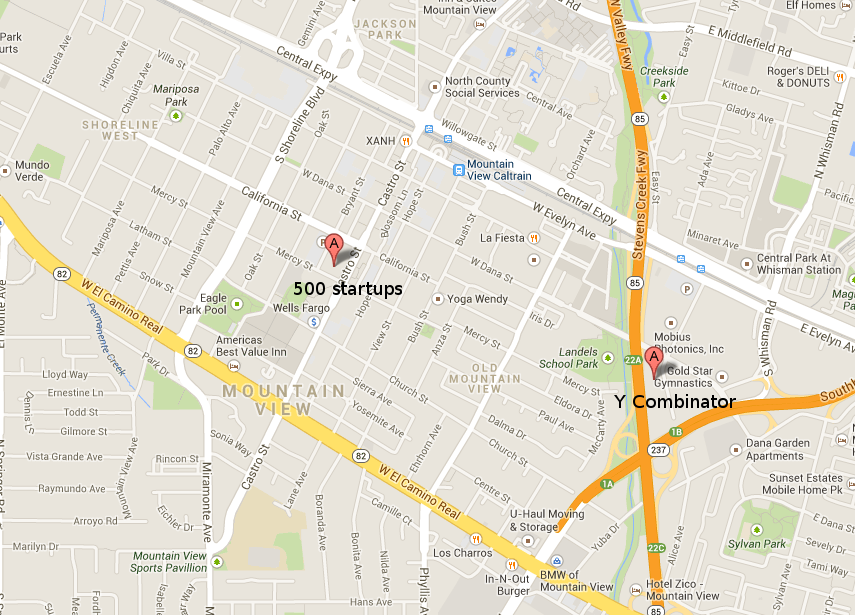
If you’re in the area running solo, freelancing, just checking it out or just want a social place to do some work and don’t mind not having a permanent desk, then coworking spaces are for you.
In the Valley, there is no question that Hacker Dojo is the place to be. Open 24/7 to members, membership costs only $100 per month and you can give a few days notice before the next payment if you want to cancel.
In San Francisco, Noisebridge, located in the Mission, is a hackerspace that’s more geared to hardware. A little bit more formal is PARISOMA, in SoMa. Membership for the open space costs $300 with one month notice before leaving. Other (more expensive) alternatives, are for example WeWork.
Food
If you’re working at a company with free food (Google, Facebook and the likes), you can probably skip this section.
If you’re cooking, you’ll be able to save a lot more money and perhaps eat a little better. The next section tells you about where to buy stuff.
If you are eating out, the choice is plenty. Many different types of cuisine are available: Indian, Pakistani, Italian, American, Mexican, Chinese, Thai, Vietnamese, Japanese, etc. The cheapest prices can range from $5-6 for a sandwich to ~$15 for dinner (don’t forget a 15-20% tip). Prices between the Valley and San Francisco don’t differ too much with the Valley being a bit cheaper (and I have the impression that the East Bay can be a little bit more affordable).
For finding a place to eat, Yelp is the winner, even though their search/filtering suck. Search the area of desire, filter by $ and sort by rating.
Groceries
The Bay Area is very conscious of its food. You’ll see labels flying around the markets saying “organic” and/or “local”.
The big market chains are Safeway (open 24/7), Trader Joe’s, Whole Foods, Costco and Walmart. You will also have the local markets, specific to your location. Don’t forget to BYOB (Bring Your Own Bags). An alternative is to buy online, but that’s only if you’re not trying to save some money. Instacart or the website of the store are good options.
If you’re going to shop at Safeway, get a Safeway Card. Plenty of discounts if you have a card.
Transportation
San Francisco ↔ Silicon Valley
The Caltrain is the train system that connects the South Bay and Peninsula to San Francisco. It goes from San Jose to the SOMA district (4th Street and King). It is widely used, always packed during rush hours. Some of the trains are bullet trains, meaning that they don’t stop at all stops. The last Caltrain is at around 10pm (northbound) or midnight (southbound), except on Sundays, where the last trains departs at around 9pm.
San Francisco ↔ East Bay
The BART is the train system that connects (mainly) San Francisco and the East Bay. It goes from Millbrae and the San Francisco Airport (SFO) to the far ends of the East Bay (Fremont, Dublin/Pleasanton, Pittsburg/Bay Point and Richmond). The stops in San Francisco only cover the east side of the city.
Traffic in the Bay Area can seem strange at first sight. It’s one of the few places where, in the morning, the traffic jams from the City to the Suburbs and, in the afternoon, from the Suburbs to the City. This is because a lot of people live in the City and commute to the Peninsula/South Bay to work.
For getting around in San Francisco, you can catch the MUNI, the major public transportation system in the city, covering most of it with its buses and a few metropolitan-like trains. Unfortunately it is not the most reliable system, so it is not uncommon to experience random delays. A ride costs $2. Make sure you bookmark NextMuni for actual MUNI times.
My preferred transportation system is the bicycle. San Francisco has plenty of bike routes. Google Maps has an okay bike route option but it doesn’t seem to take into much consideration the steepness of the paths. This calculator might help you with that.
You might find good deals for bikes on Craigslist or you can decide to buy them online from Bike’s Direct - the only con is that you’ll have to assemble it yourself or pay ~$70 for a bike shop to do it for you. And if you’re depending on your bike for everything (like carrying your groceries), get a bike rack and a basket or a case from Amazon. Oh, and BUY A GOOD LOCK (Kryptonite Kryptolok) AND MAKE SURE EVERYTHING’S CORRECTLY LOCKED.
If you’re riding the BART or the Caltrain (and have an iOS device), try the Embark (acquired by Apple) apps for schedules. You’ll also probably want to get the Clipper Card (which also works for the MUNI) and link it to your credit card, so you don’t have to keep recharging it.
Due to the unreliability of the MUNI, the fact that the BART does not cover the whole town, the Caltrain ending “early”, it is easy to understand the popularity of ride-sharing/private taxi transportation systems services such as Uber, Zipcar, Lyft, etc.
If you’re going to San Francisco, only take the car as a last resort. More than the traffic, parking is a big pain (and a great money maker for the town in parking tickets): hard to find and expensive in parking garages ($10-20).
Communications
US mobile plans are a bit more expensive than I’d like. The big phone carriers are Verizon, AT&T, T-Mobile and Sprint. According to testimonies from friends, AT&T and Verizon are pretty good all around. T-Mobile’s reception can be shaky in some places. I have no idea about Sprint.
There are plenty of resellers that use the big carriers’ networks. I go with one of the resellers: Straight Talk. They offer unlimited text and voice (US only) and “unlimited” data (that actually gets capped if you abuse it - and might get you completely cut, so beware). But it’s hard to beat the price: $45 per month. You must bring your own device. In the Bay Area, Straight Talk uses T-Mobile’s network. For international calls, just use Skype.
I haven’t had first hand experience with wired internet connection, so I can’t talk much about that (edit: people have suggested Sonic.net.
Life is for Living, Activities, etc
You should be exercising [1]. Here are some options:
-
24 Hour Fitness gyms (some are not really open 24/7 and not everyone likes the chain, so watch out); Fitness SF if you’re in the city; more options here
-
Jogging
-
Hiking, Biking, Rock Climbing
-
Yoga, Martial Arts
Points of interest? In the City, the more touristic stuff: Twin Peaks, Golden Gate, Alcatraz, SF MoMA, etc. Get a CityPASS. Want a more tech-route? Check Paul’s list.
Want to learn about tech from the most experienced people and/or meet new people that do not come from your circle (or maybe you just dropped solo and know no one)? Go to tech meetups. Pick the groups based on technologies you know or want to learn and you’ll be able to visit a bunch of tech offices. And most of the meetups have food for you! Some companies also sponsor some meetups outside of the Meetup platform, like Airbnb - it’s a good way for them to build their brand for engineers and recruit people.
I find hackathons [1] [2] to be a great way to try out new concepts and/or technologies in a very constrained environment - you have limited time (usually a weekend), forcing you to be objective and resourceful. (tip: It’s also a great way to develop your pitching skills). And if you learn to be picky, some have intere$ting prizes and, of course, free food! The big hackathons will also have sponsors with free swag (e.g., t-shirts so you can delay doing your laundry for another week).
Shopping
It would be cool if the free swag companies offered would go beyond t-shirts to include pants - that would complement so well. Since that hasn’t happened yet, you can buy clothes at affordable prices from a bunch places: thrift stores around the City and the East Bay, Ross Dress for Less. Even big name brands like Levi’s have stuff at poor-hacker prices.
Conclusion
If you are a struggling hacker, you’ll be wanting to minimize your burn rate. Your two big expenses will be rent and food. Depending if you’re in the Valley or in the City, you might have to get a car (it’s harder to be car-free when living in the Valley).
In the Valley, I spent a little bit less than $2000 per month (rent+food+gas+dojo membership). In the City, in the beginning I had a similar burn rate but mainly because I was eating out every meal. You should pay upfront for a bike and avoid any future transportation costs (and it’s good exercise). Buying stuff in the market and cooking have halved my expenses with food (about $20 per day).
So that’s pretty much it. I’ll try and update this post with any tips that I might learn/recall. Hope it helps.
Conception date: September 17th, 2013
